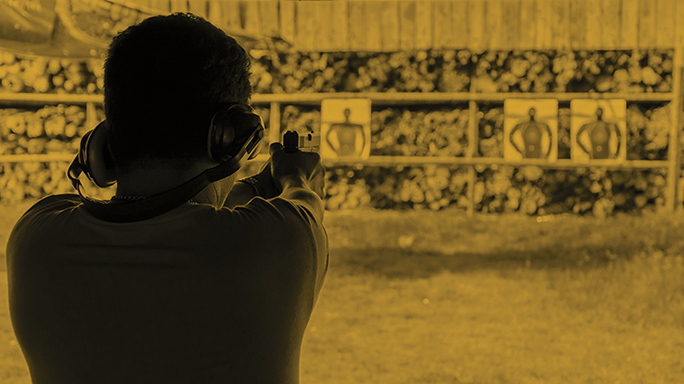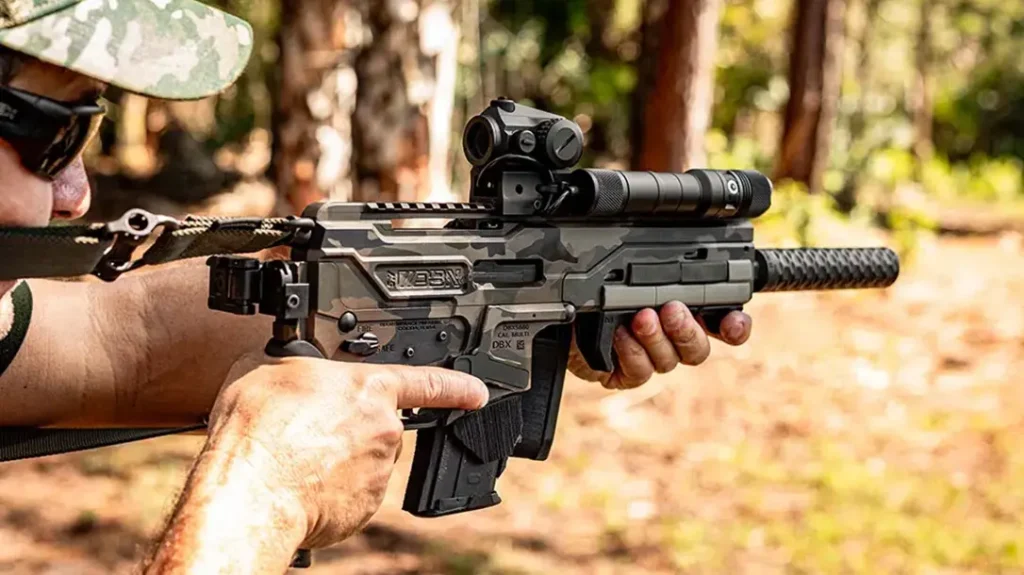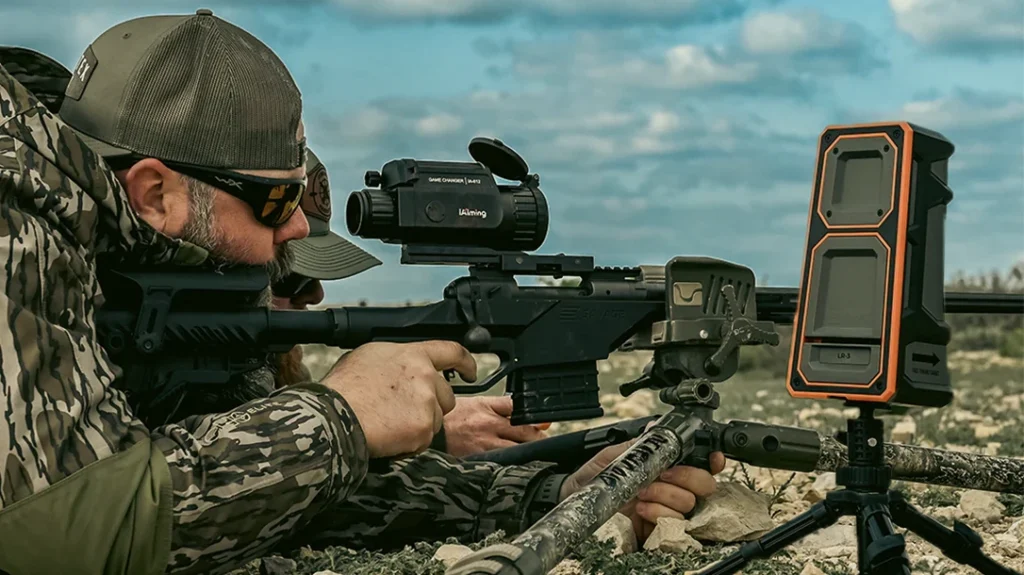Elevate Your Game
The most common and popular competitive action-shooting disciplines for handguns are the United States Practical Shooting Association (USPSA) and the International Defensive Pistol Association (IDPA). Between them, they boast some 50,000 members, and they continue to grow every year. USPSA is generally known for its “freestyle” options, where competitors are presented with a course of fire and shoot it however they want to achieve their best result. IDPA has more of a focus on defensive shooting situations, incorporating stage design and rules intended to encourage tactically sound behavior, such as use of cover and engaging close threats before far threats. No matter which type of match you enter, you will be required to strike a balance between speed and accuracy while adding movement and other challenges to the mix — all under the pressure of a timer.
Perhaps you’ve heard people say something like, “Competition and shooting games will get you killed on the streets.” Before you write off participating in shooting sports, let’s take a closer look. As with most things in life, you typically get out of it what you put into it. Are you looking for a recreational activity, a great way to spend a day at the range? Are you looking to sharpen your technical skills? Do you want to get serious about winning matches? Or are you primarily concerned about self-defense, duty or military applications?
RELATED STORY: Top 10 Advantages of Competition For Cops
Competitive shooting can absolutely help with all of these things — just approach it with your personal objectives clearly in mind. Shooting matches are no substitute for quality training, which can provide you with proper fundamentals, but they are a fantastic way to apply, refine and practice what you’ve learned. It’s a great chance to improve your shooting and weapon-manipulation skills.
Advertisement — Continue Reading Below
When all is said and done, though, these pursuits are still contests, with competitors’ results ranked against one another. To make rankings more meaningful for participants, both organizations separate competitors into different divisions and classes, so that you are compared against others with similar equipment and skill level. Let’s take a closer look.
IDPA
Breaking Down IDPA
The IDPA was founded in 1996 to promulgate a shooting sport that emulates self-defense scenarios and real-life encounters. The IDPA looks to mandate the use of practical equipment and techniques, where you can be competitive with a duty or CCW gun and concealment holster, and tries to discourage too much focus on equipment.
It’s very easy to get started in IDPA. In fact, IDPA stages may not require more than 18 rounds at a time (excluding your misses, of course). You could most likely reach in your safe, scrounge around your garage and be ready to shoot an IDPA match. On the other hand, folks who prefer higher round counts for their time at the range may wish to look more closely at USPSA competitions.
Advertisement — Continue Reading Below
Right Gun For The Right Class
Striker-fired, double-action/single-action and double-action-only semi-automatic firearms are suitable for SSP, CCP or BUG divisions. Any handgun allowed in SSP can also be used in ESP or CDP, depending upon modifications and caliber. Single-action semi-automatic firearms compete in ESP, CCP, CDP or BUG, depending upon their size and caliber. Revolvers are classified by loading method and caliber, and may also be used for the BUG division. Sound confusing? Allow us to break down all these acronyms here.
1. Stock Service Pistol (SSP)

The SSP requires semi-automatic handguns in 9mm or larger that are striker-fired, double-action/single-action or double-action only. Additional size and weight limitations apply (8.75 by 6 by 1.625 inches and 43 ounces), and only certain modifications are allowed. Magazines are loaded to a maximum of 10 rounds. Glocks, XDs and M&P pistols are commonly seen in this division. Larger variants of the Glock like the G34 are quite popular — perhaps pushing the boundaries of what one might carry daily versus prioritizing better match results.
Advertisement — Continue Reading Below
2. Enhanced Service Pistol (ESP)

This division is similar to the SSP with the addition of single-action-only weapons and the allowance of more modifications, like extended magazine wells for speedier reloads. Magazines are loaded to a maximum of 10 rounds. More extensively modified Glocks and M&Ps are seen here, along with XDs and 9mm 1911 variants.
3. Custom Defensive Pistol (CDP)

Advertisement — Continue Reading Below
This division uses semi-auto .45 ACP handguns. With a magazine limitation of a maximum of eight rounds, think of CDP as the John Moses Browning (i.e., 1911) division.
4. Compact Carry Pistol (CCP)

A new division created this year, the CCP is similar to ESP but more compact — the barrel length must be 4.1 inches or shorter and the width thinner (1.325 inches or less). Magazines are loaded to a maximum of eight rounds. Examples of guns commonly seen in this division include the Glock 19, M&Ps, VP9 and shorter-barreled 1911s.
Advertisement — Continue Reading Below
5. Revolver (REV)

This includes Stock Revolver and Enhanced Revolver divisions. The barrel length must be 4.25 inches or less, and cylinders can be loaded to a maximum of six rounds. L-Frame S&Ws and Ruger GP100s are popular for Stock Revolver, which must be .38 Special or larger, weigh no more than 43 ounces and cannot accept moon clips. Enhanced Revolvers have to be .357 Magnum or larger, can weigh up to 50 ounces and can take moon clips.
6. Back-Up Gun (BUG)

Advertisement — Continue Reading Below
Semi-autos and revolvers can be used in the BUG division. Semi-autos must be .380 auto or larger, have a barrel length of 3.6 inches or less, be no larger than 7.25 by 5.5 by 1.325 inches and weigh 29 ounces or less. Revolvers in this division must be .38 or larger, have barrels of 3 inches or less, be less than 8.75 by 5.5 by 1.625 inches in size and weigh 38 ounces or less. The guns can only be loaded to six rounds. The M&P Shield is a good example for this division.
Get Classified
Once you sign up as an IDPA member and begin shooting matches, you will eventually be classified into different skill levels based on your performance in matches or on a designated classifier course of fire. That way you’ll be compared against others with similar skills and equipment. You’ll start unclassified and then be assessed as a Novice, Marksman, Sharpshooter, Expert, Master or Distinguished Master.
USPSA
Breaking Down USPSA
The International Practical Shooting Confederation (IPSC) was formed in 1976, followed by the domestically focused USPSA organization in 1984. The USPSA aims to test the shooter’s expertise in balancing accuracy, power and speed. It is known for higher round counts, fast and challenging courses of fire, and top competitors who display seemingly inhuman feats of shooting skill.
Advertisement — Continue Reading Below
The USPSA is also often associated with space-age race guns and people running around in shirts emblazoned with sponsor logos (think stock cars with holsters). But you needn’t have a trust fund or sponsorships to play. As we’ll explain, the production division is quite simple to ease into. And you needn’t strive to win at all costs, either; you’re more than welcome to shoot a match however you like — shoot from concealment, practice using cover, whatever fits your priorities. But you’ll still learn to engage targets as quickly and accurately as possible, and can use the scoring to track your own progress over time.
Divisions From Mild To Wild
In keeping with the USPSA’s freestyle spirit, there’s a lot of flexibility in its equipment divisions. Production is a great place to start, as you can get going with a bone-stock service pistol. Once you get hooked, you can feed your wildest addictions by moving into other divisions.
7. Production

Advertisement — Continue Reading Below
Intended to capture mostly stock factory handguns (at least in appearance), including semi-automatic pistols (9mm or larger) and revolvers (.38 or larger). Semi-autos must not be larger than 8.9375 by 6 by 1.625 inches, and magazines cannot be loaded with more than 10 rounds, meaning that you’ll get a lot of practice reloading your weapon. Modifications to the gun are restricted (especially externally visible ones), though there’s still a fair amount that you can do. Holsters must be of a closed design. Striker-fired polymer guns are very popular in this division.
8. Limited

This is a very popular division featuring 9mm or larger semi-automatic handguns, but with few other restrictions beyond iron sights and no compensators or ports. You’ll see everything from Glocks, M&Ps and CZs tricked out with light triggers, extensive slide work and mag wells to full-house custom 2011 builds. The magazine length is limited to 141mm.
9. Limited-10

Similar to Limited, except no more than 10 rounds are to be loaded in any magazines.
10. Single-Stack

As the name implies, you’ll see 9mm, .40 S&W and .45 ACP 1911s in this division. Size requirements are similar to Production division, and only certain modifications are allowed. For minor power factor (e.g., 9mm), mags are loaded to 10 rounds, and for major power factor (see explanation below), eight rounds.
11. Open

Almost anything goes in Open division with no restrictions on size or weight — but in particular red-dot optics and fire-breathing compensators are the hallmarks of these guns. While various platforms are used for Open guns, expensive 2011-based custom builds dominate this division. Serious competitors handload their ammunition to meet power factor requirements while optimizing recoil management. Just about the only restriction is the overall length of magazines, at 171mm.
12. Revolver

This division has a minimum caliber of .38 Special, with eight rounds allowed for minor power factor and six for major power factor. Otherwise, there are no size or weight restrictions, but compensators and ports are not allowed and iron sights are required.
Grand Master Class
As a USPSA member, you will be placed into different skill levels based on your performance on classifier courses of fire as compared to the high scores turned in by other competitors. From low to high, classifications include D class, C class, B class, A class, Master and Grand Master. In any particular match, you’ll be scored and ranked against other shooters in your particular class and equipment division. There always may be some folks, known derisively as sandbaggers, who try to intentionally get classified in lower classes than they should, in hopes of scoring better within that class. But the system is designed to eventually self-correct for that bit of unsportsmanlike conduct.
The IDPA and USPSA are both an absolute hoot to shoot. And you’ll almost certainly become a better shooter as a result. You owe it to yourself to give action-shooting sports a try.
What Do You Need to Compete?
- Reliable handgun
- Spare magazines (or speed-loaders/moon clips for revolvers)
- Holster
- Cargo pants
- Sturdy belt
- Ammo
- Magazine pouches
- Eye protection
- Ear protection
- Good attitude
Power Factor
Power factor is a calculation designed to level the playing field between competitors with baseline requirements for ammunition used in competitions. The power factor for a particular weapon and ammunition combination equals the product of multiplying bullet weight (in grains) by muzzle velocity, then dividing it by 1,000. This prevents a shooter from hand-loading a very soft round and gaining an unfair advantage over others using regular ammunition.
The USPSA specifies “minor” and “major” power factor levels, which, generally speaking, equate to factory 9mm for the former and factory .40 S&W for the latter, and which are scored differently. The IDPA doesn’t have multiple power-factor levels, but prescribes minimum levels for each equipment division.
If you’ve never tried action-shooting sports before, you’re missing out. We’ve seen it time and time again: Take someone who’s only ever shot on a line at a typical firing range and introduce them to moving around, shooting multiple targets, dealing with interesting props, and you might just hear responses like, “That was better than ice cream!” Well, we’re not quite sure about that, but having a blast while improving your craft — what’s not to like?
























